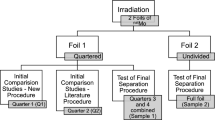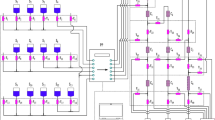Abstract
For large-scale production of silicon isotopes, chemical exchange reaction and gas centrifugation are the most prospective methods. Advances in these two methods are reviewed in this article. With brief introduction of the principles, the progress and problems in these two methods are discussed. New donors and the benefits of the combination of these two separation methods are introduced. Among these donors trimethyl phosphate is more suitable in chemical exchange reaction due to its separation coefficient, freezing point and stability. Moreover, the combination of separation methods is a promising technology to massively perform silicon isotope.






Similar content being viewed by others
References
Lyman JL, Newnam BE, Noda T, Suzuki H (1999) Enrichment of silicon isotopes with infrared free-electron laser radiation. J Phys Chem A 103(21):4227–4232
Ruf T, Henn RW, Asen-Palmer M, Gmelin E, Cardona M, Pohl HJ, Sennikov PG (2000) Thermal conductivity of isotopically enriched silicon. Solid State Commun 115(5):243–247
Kazan M, Guisbiers G, Pereira S, Correia MR, Masri P, Bruyant A, Royer P (2010) Thermal conductivity of silicon bulk and nanowires: effects of isotopic composition, phonon confinement, and surface roughness. J Appl Phys 107(8):083503
Tyryshkin AM, Tojo S, Morton JJ, Riemann H, Abrosimov NV, Becker P, Lyon SA (2012) Electron spin coherence exceeding seconds in high-purity silicon. Nature Mater 11(2):143–147
Itoh KM, Watanabe H (2014) Isotope engineering of silicon and diamond for quantum computing and sensing applications. arXiv preprint arXiv:1410.3922
Dwyer KJ, Pomeroy JM, Simons DS, Steffens KL, Lau JW (2014) Enriching 28Si beyond 99.9998 % for semiconductor quantum computing. J Phys D 47(34):345105
Inyushkin AV, Taldenkov AN, Gusev AV, Gibin AM, Gavva VA, Kozyrev EA (2013) Thermal conductivity of the single-crystal monoisotopic 29Si in the temperature range 2.4–410 K. Phys Solid State 55(1):235–239
Becker P (2003) Tracing the definition of the kilogram to the Avogadro constant using a silicon single crystal. Metrologia 40(6):366
Massa E, Mana G, Ferroglio L, Kessler EG, Schiel D, Zakel S (2011) The lattice parameter of the 28Si spheres in the determination of the Avogadro constant. Metrologia 48(2):S44–S49
Becker P, Bettin H (2011) The Avogadro constant: determining the number of atoms in a single-crystal 28Si sphere. Philos Trans R Soc A 369(1953):3925–3935
Becker P, Schiel D (2013) The Avogadro constant and a new definition of the kilogram. Int J Mass spectr 349:219–226
Narukawa T, Hioki A, Kuramoto N, Fujii K (2014) Molar-mass measurement of a 28Si-enriched silicon crystal for determination of the Avogadro constant. Metrologia 51(3):161
Verhulst AS, Maryenko D, Yamamoto Y, Itoh KM (2003) Double and single peaks in nuclear magnetic resonance spectra of natural and 29Si-enriched single-crystal silicon. Phys Rev B 68(5):054105
Pla JJ, Mohiyaddin FA, Tan KY, Dehollain JP, Rahman R, Klimeck G, Morello A (2014) Coherent control of a single silicon-29 nuclear spin qubit. arXiv preprint arXiv:1408.1347
Yamada Y, Yamamoto H, Ohba H, Sasase M, Esaka F, Yamaguchi K, Hojou K (2007) Local neutron transmutation doping using isotopically enriched silicon film. J Phys Chem Solids 68(11):2204–2208
Ohba H, Akagi H, Katsumata K, Hashimoto M, Yokoyama A (2008) Practical method for producing a large amount of isotopically enriched silicon by infrared multi-photon dissociation of hexafluorodisilane. Jpn J Appl Phys 47(11R):8379
Gruber C, Harpaz L, Zhu C, Bullen TD, Ganor J (2013) A new approach for measuring dissolution rates of silicate minerals by using silicon isotopes. Geochim Cosmochim Acta 104:261–280
Becker P, Pohl HJ, Riemann H, Abrosimov N (2010) Enrichment of silicon for a better kilogram. Phys Status Solidi A 207(1):49–66
Churbanov MF, Gusev AV, Bulanov AD, Potapov AM (2013) Monoisotopic varieties of silicon and germanium with a high chemical and isotopic purity. Russ Chem B 62(2):270–275
Becker P, Schiel D, Pohl HJ, Kaliteevski AK, Godisov ON, Churbanov MF, Dianov EM (2006) Large-scale production of highly enriched 28Si for the precise determination of the Avogadro constant. Meas Sci Technol 17(7):1854
Sennikov PG, Kornev RA, Mochalov LA, Golubev SV (2014) PECVD preparation of silicon and germanium with different isotopic composition via their tetrafluorides. J Phys 514(1):012002
Mills TR (1990) Silicon isotope separation by distillation of silicon tetrafluoride. Sep Sci Technol 25(3):335–345
Li WB, Li DY, Wu JJ (2006) Summarization about applied background of 28Si isotope and actuality in separating 28Si. At Energy Sci Technol (China) 40(B09):200–203
Dementyev PS, Nizovtsev AS, Chesnokov EN (2011) Infrared photoreaction of 2-chloroethyltrifluorosilane. J Photochem Photobiol A 222(1):77–80
Alcaraz AN, Codnia J, Azcárate ML (2011) Optimization of the infrared multiple- photon dissociation of SiF4 to increase the isotopic selectivity. J Phys 274(1):012091
Shiomi Y, Kumagai H (2008) Isotopic separation of silicon atoms by atomic mirror. Nucl Instrum Methods B 266(23):5047–5049
Korolev VA, Mashirov LG, Perepech KV, Polyakov MS, Shil’nikov AY, Godisov ON, Kovarskii AP (2002) Separation of silicon isotopes by silicon tetrafluoride- silane technology. Inorg Mater 38(6):539–541
Ager JW III, Beeman JW, Hansen WL, Haller EE (2004) Design, construction, and operation of a laboratory scale reactor for the production of high-purity, isotopically enriched bulk silicon. Lawrence Berkeley National Laboratory, Berkeley, United States. http://www.osti.gov/scitech/biblio/862010-1f1Fxv/
Moutanabbir O, Senz S, Zhang Z, Gösele U (2009) Synthesis of isotopically controlled metal-catalyzed silicon nanowires. Nano Today 4(5):393–398
Anchihrov AV, Fedorov SN, Cherednychenko SA, Khoroshilov AV (2005) Comparative evaluation of physico-chemical concentration methods of silicon isotopes. Abstracts of the 8th international youth conference. http://www.polar.mephi.ru/ru/conf/2005/4_perspektivy/4_anchihrov.html
Borisevich VD, Khoroshilov AV, Cherednichenko SA (2005) Thermal conductivity of silicon-28 and separation technology for its production. 5th international conference on isotopes brussels, Belgium
Abesadze T, Manning DK, Saunders WE, Wachs MY (2000) Enrichment of silicon or germanium isotopes. U.S. patent 6,146,601[P]. 2000-11-14
Razmadze AA, Tolmachev AM (2010) Determination of physicochemical parameters of 28Si isotope enrichment in countercurrent column. Russ J Phys Chem A 84(2):304–306
Song S, Mu Y, Li X, Bai P (2010) Advances in boron-10 isotope separation by chemical exchange distillation. Ann Nucl Energy 37(1):1–4
Hanschmann G (1982) Reduzierte zustandssummenverhaltnisse isotope molecule auf quantenchemischer grundlage. Isotopenpraxis 18(6):203
Ponomarev A, Fedorov SN, Suchkova EV, Cherednychenko SA, Khoroshilov A (2007) Physicochemical properties of aliphatic alcohols and their complex compounds with silicon tetrafluoride. Adv Chem Chem Technol (Russia) 8(76):30–34
Fedorov SN, Ponomarev AG, Nevolina N Yu (2008) Features determining of the silicon tetrafluoride sorption capacity to pentanol for separation processes silicon isotopes. 11th international youth scientific conference: abstracts (Russia), pp 224–226
Fedorova SN, Nevolina NY, Ponomarèva AG, Cherednychenko SA, Khoroshilov AV (2008) Effect of temperature on the silicon tetrafluoride absorption process to pentanol-1. Adv Chem Chem Technol (Russia) 9(89):7–10
Khoroshilov AV, Cherednichenko SA (2007) Phase and isotope equlibria in systems of SiF4 with the complex compounds of SiF4 with aliphatic alcohols as applied to the separation of silicon isotopes. Khim Tekhnol 8(2):53–58
Khoroshilov AV, Cherednichenko SA, Lizunov AV, Fedorova SN (2010) Separation of silicon isotopes by chemical exchange between silicon tetrafluoride and its complex compounds with aliphatic alcohols. Theor Found Chem Eng 44(4):569–573
Ennan AA, Gavrilova LA (1986) The dehydrofluorination of complexes of silicon tetrafluoride with nitrogen-and oxygen-containing donor ligands. Russ Chem Rev 55(9):843
Waki M, Miyamoto K (2011) Isotope enrichment method. U.S. patent 7,943,107 [P]. 2011-5-17
Ivanova S (2013) Separation of isotopes of silicon chemical exchange between silicon tetrafluoride and its complexes with trimethyl phosphate. Russ Univ Chem Technol, Moscow, pp 1–15
Wu XQ, Bai P, Guo XH, He NN (2014) 2,4-Difluoro anisole: a promising complexing agent for boron isotopes separation by chemical exchange reaction and distillation. J Radioanal Nucl Chem 300:897–902
Khoroshilov AV, Fedorov SN, Stepanov AV, Pavlov VI, Semenov NA (2010) Trace silicon in trimethyl phosphate and enrichment boundary of 28Si in chemical exchange. Trace Elem Med (Russia) 11(3–4):95–98
Szady AJ (1989) Enrichment of chromium isotopes by gas centrifugation. Nucl Instrum Methods A 282(1):277–280
Tarbeyev YV, Kaliteyevsky AK, Sergeyev VI, Smirnov RD, Godisov ON (1994) Scientific, engineering and metrological problems in producing pure 28Si and growing single crystals. Metrologia 31(3):269
Levin EV, Ying CT (1994) The effect of multicomponent isotope mixture mole fractions on the separation parameters of a gas centrifuge. Workshop on separation phenomena in liquids and gases, Beijing, China
Aisen EM, Borisevich VD, Levin EV, Popov GE, Tikhomirov AV, Yupatov SV (1996) Study of isotope separation of some chemical elements in a gas centrifuge. Nucl Instrum Methods A 374(1):127–131
Godisov ON, Kaliteevskii AK, Korolev VI, Ber BY, Davydov VY, Kaliteevskii MA, Kop’ev PS (2001) Preparation and properties of isotopically pure polycrystalline silicon. Semiconductors 35(8):877–879
Abrosimov NV, Riemann H, Schröder W, Pohl HJ, Kaliteevski AK, Godisov ON, Zhilnikov AJ (2003) 29Si and 30Si single crystal growth by mini-Czochralski technique. Cryst Res Technol 38(7–8):654–658
Itoh KM, Kato J, Uemura M, Kaliteevskii AK, Godisov ON, Devyatych GG, Riemann H (2003) High purity isotopically enriched 29Si and 30Si single crystals: isotope separation, purification, and growth. Jpn J Appl Phys 42(10R):6248
Riemann HP, Abrosimov N, Hallmann-Seiffert B, Kaliteevski A, Godisov O, Gusev A, Becker P (2008) The way of making monoisotopic FZ-Si crystals for the new kg mass unit standard and for basic research. ECS Trans 16(6):351–356
Sennikov PG, Vodopyanov AV, Golubev SV, Mansfeld DA, Drozdov MN, Drozdov YN, Valkiers S (2012) Towards 0.99999 28Si. Solid State Commun 152(6):455–457
Babichev AP, Zhernova ZY, Kurochkin AV, Mishachev AA, Popov GE, Rudnev AI, Tikhomirov AV (2002) Toward 28Si through trichlorosilane. Inorg Mater 38(5):425–426
Zhou MS, Wei XF, Zeng S (2006) Production of highly enriched 28Si using SiHCl3 as the processing gas. J Tsinghua Univ (China) 45(12):1640–1642
Zhang XZ, Deng N, Zhou MS (2005) Fabrication and property test of isotopic pure Si transistors. The monograph of academic annual conference held by China Association for Science and Technology, Beijing, China, pp 1–3
Mou H, Li DY, Li WB (2008) Experimental study of optimization of the feed flow of single unit for Si isotope separation. J Isot 21:65–69
Gusev AV, Bulanov AD (2008) High-purity silicon isotopes 28Si, 29Si, and 30Si. Inorg Mater 44(13):1395–1408
Pul’Nikov II, Rjabukhin AV, Sharin GA, Senchenko VV, Palienko AA (2005) Method of production of a high-enriched isotope silicon-28. RU patent 2265476C2[P]. 2005-12-10
Author information
Authors and Affiliations
Corresponding author
Rights and permissions
About this article
Cite this article
Wang, C., Bai, P. & Guo, X. Advances in separation methods for large-scale production of silicon isotopes. J Radioanal Nucl Chem 304, 989–999 (2015). https://doi.org/10.1007/s10967-015-3950-7
Received:
Published:
Issue Date:
DOI: https://doi.org/10.1007/s10967-015-3950-7




